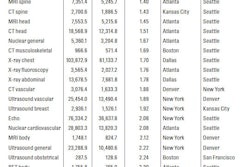The healthcare reform legislation that passed the U.S. Congress on March 21 contains many provisions that haven't garnered the same level of attention as the Cornhusker kickback or the Stupak abortion amendment. But radiology is keenly interested in a number of the more arcane sections of the bill.
On March 23, President Barack Obama is expected to sign into law HR 3590, the Patient Protection and Affordable Care Act, essentially the Senate's healthcare reform bill that passed the house on Sunday. Once he does, the bill will establish a number of regulations concerning radiology, ranging from new reimbursement rates to self-referral disclosure.
Perhaps the most important of the bill's provisions affecting medical imaging is a change in the equipment utilization rate, or the rate at which imaging equipment is assumed to be in use at the average facility. The reform legislation would set the rate for all advanced diagnostic imaging services at 65% through 2012, 70% in 2013, and 75% in 2014 and beyond.
But there's a wrinkle.
That's because also on Sunday, the House passed another bill intended to reconcile a few of HR 3590's provisions with the House's own version of healthcare reform. HR 4872, or the Health Care and Education Affordability Reconciliation Act, would make the utilization rate -- for imaging equipment costing more than $1 million -- 75% starting in 2011. The bill is now headed back to the Senate for approval.
In addition, HR 4872 would also delay excise tax levied on companies for the first sale for use of medical devices at a rate of 2.9% (excluding class I medical devices).
"Now the House's reconciliation bill goes back to the Senate, and the Senate has to review those changes and approve them," said Cynthia Moran, assistant executive director for government relations at the American College of Radiology (ACR) in Reston, VA. "If there are no changes -- literally, even no changed commas -- then the bill will go to the president."
The Senate bill passed by the House on Sunday makes the following provisions that will not be further challenged:
- The percentage discount for the Medicare technical component of consecutive body parts imaged in a single imaging session will increase from 25% to 50% of the normal technical fees for MRI, CT, or PET imaging of the contiguous region.
- The U.S. Centers for Medicare and Medicaid Services (CMS) will establish a demonstration project that will offer incentives to referring physicians to use appropriateness criteria when ordering advanced imaging tests.
- Physicians will be obligated to provide patients with written disclosure of their ownership interest in imaging equipment, as well as a list of alternative imaging sites the patient can use.
If the House reconciliation bill fails to pass the Senate, HR 3590 will become the law of the land, Moran said.
"When you think about it, the Senate got the House to pass its bill without any changes," Moran said. "But how compelled will the Senate feel to revisit the House's [reconciliation bill] changes?"
By Kate Madden Yee
AuntMinnie.com staff writer
March 23, 2010
Related Reading
Obama optimistic on weekend healthcare vote, March 19, 2010
U.S. budget analysts say health bill to cut deficit, March 18, 2010
U.S. House Democrat says still short on health votes, March 15, 2010
U.S. Democrats move closer to healthcare deal, March 12, 2010
Obama: Time for talk is over on healthcare bill, March 12, 2010
Copyright © 2010 AuntMinnie.com



















